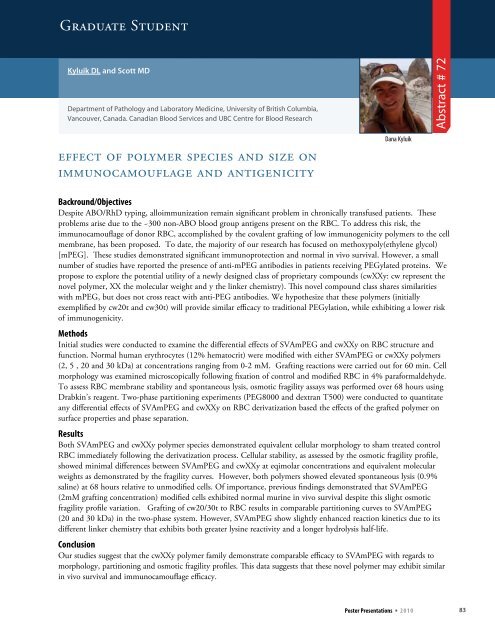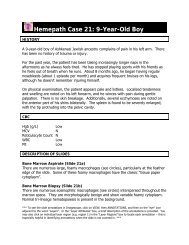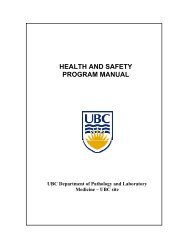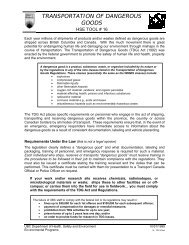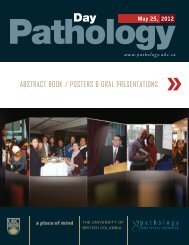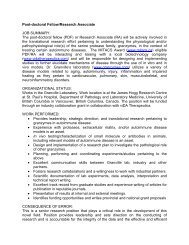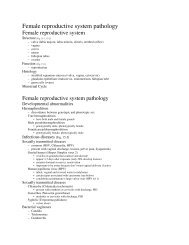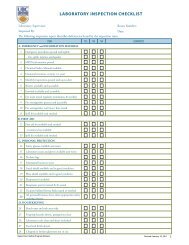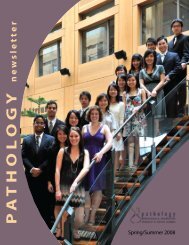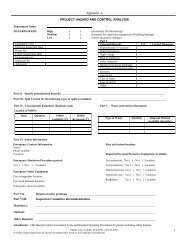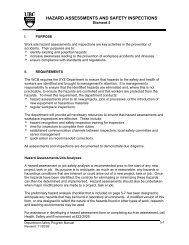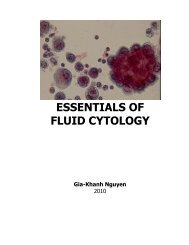OtherAbstract # 71Mary Zhang, Xin Ye, Gomaa MH Hemida, Stefanie Mak <strong>and</strong> Decheng YangDepartment of <strong>Pathology</strong> <strong>and</strong> <strong>Laboratory</strong> <strong>Medicine</strong>, <strong>University</strong> of British Columbia,Heart + Lung Institute + St. Paul’s Hospital, Vancouver, CanadaMary Zhangcoxsackievirus b3-induced downregulation of p58ipk isinvolved in shifting endoplasmic reticulum stress tocell apoptosisBackround/ObjectivesUnfolded (or misfolded) protein responses (UPR) are linked to occurrences of many pathological disorders, such asneuron degeneration, cystic fibrosis, diet-induced obesity, type 2 diabetes <strong>and</strong> virus-induced diseases. CoxsackievirusB3 (CVB3) is a common pathogen of viral myocarditis in children <strong>and</strong> young adolescents <strong>and</strong> its infection can triggerendoplasmic reticulum (ER) stress-mediated UPR. p58IPK is one of the signaling molecules that are involved inthe UPR pathway. It is a negative regulator of eIF2a signaling in cellular mRNA translation process. Although theinteractions between p58IPK <strong>and</strong> other signaling proteins have been determined in previous studies, the functionalrole of p58IPK during CVB3 infection has not been examined. Our previous investigations have demonstrated thatCVB3 infection induced cell apoptosis <strong>and</strong> also decreased production of p58IPK. However, the connection of thesetwo events has not been elucidated.Methods <strong>and</strong> ResultsIn this study, HeLa cells are either stably transfected with a p58IPK plasmid to over-express p58IPK or treated withspecific siRNAs to silence the p58IPK expression. These cells are then infected with CVB3 at a MOI of 10 <strong>and</strong> usedto perform a set of analyses after incubation for different periods of time. Based on the MTS cell viability assay <strong>and</strong>detection of activation of caspse-3, p58IPK-transfected HeLa cells showed a higher survival rate <strong>and</strong> lower productionof activated caspase-3 than the empty vector-transfected control cells after CVB3 infection, which suggest that p58IPKplays a role in pro-survival <strong>and</strong> anti-apoptosis process. Moreover, Western Blot analysis of these cell lysates showed ahigher expression level of viral protein VP1 <strong>and</strong> more production of CVB3 particles in p58IPK expressing cells than inthe control cells. In contrast, silencing of p58IPK by specific siRNA transfection decreased cell survival rate, sensitizedthese cells to CVB3-induced apoptosis, <strong>and</strong> eventually led to a lower expression level of VP1 as compared to thescrambled siRNA-transfected control cells as well as the non-transfected HeLa cells. Since CVB3 infection of nontransfetcedHeLa cells also downregulated p58IPK expression <strong>and</strong> up-regulated ER stress marker, the glucose regulatedprotein 78 (GRP78), our data indicates that persistent CVB3 infection will eventually induce cell death.Conclusionp58IPK, as an ER co-chaperone, plays an important role in pro-survival <strong>and</strong> anti-apoptosis. During CVB3 infection,the virus-induced ER stress responses lead to the downregulation of p58IPK expression <strong>and</strong> thus result in the transitionfrom pathway of pro-survival to pro-apoptosis.82 2 0 1 0 * P o s t e r P r e s e n t a t i o n s
Graduate StudentKyluik DL <strong>and</strong> Scott MDDepartment of <strong>Pathology</strong> <strong>and</strong> <strong>Laboratory</strong> <strong>Medicine</strong>, <strong>University</strong> of British Columbia,Vancouver, Canada. Canadian Blood Services <strong>and</strong> UBC Centre for Blood ResearchAbstract # 72effect of polymer species <strong>and</strong> size onimmunocamouflage <strong>and</strong> antigenicityDana KyluikBackround/ObjectivesDespite ABO/RhD typing, alloimmunization remain significant problem in chronically transfused patients. Theseproblems arise due to the ~300 non-ABO blood group antigens present on the RBC. To address this risk, theimmunocamouflage of donor RBC, accomplished by the covalent grafting of low immunogenicity polymers to the cellmembrane, has been proposed. To date, the majority of our research has focused on methoxypoly(ethylene glycol)[mPEG]. These studies demonstrated significant immunoprotection <strong>and</strong> normal in vivo survival. However, a smallnumber of studies have reported the presence of anti-mPEG antibodies in patients receiving PEGylated proteins. Wepropose to explore the potential utility of a newly designed class of proprietary compounds (cwXXy: cw represent thenovel polymer, XX the molecular weight <strong>and</strong> y the linker chemistry). This novel compound class shares similaritieswith mPEG, but does not cross react with anti-PEG antibodies. We hypothesize that these polymers (initiallyexemplified by cw20t <strong>and</strong> cw30t) will provide similar efficacy to traditional PEGylation, while exhibiting a lower riskof immunogenicity.MethodsInitial studies were conducted to examine the differential effects of SVAmPEG <strong>and</strong> cwXXy on RBC structure <strong>and</strong>function. Normal human erythrocytes (12% hematocrit) were modified with either SVAmPEG or cwXXy polymers(2, 5 , 20 <strong>and</strong> 30 kDa) at concentrations ranging from 0-2 mM. Grafting reactions were carried out for 60 min. Cellmorphology was examined microscopically following fixation of control <strong>and</strong> modified RBC in 4% paraformaldehyde.To assess RBC membrane stability <strong>and</strong> spontaneous lysis, osmotic fragility assays was performed over 68 hours usingDrabkin’s reagent. Two-phase partitioning experiments (PEG8000 <strong>and</strong> dextran T500) were conducted to quantitateany differential effects of SVAmPEG <strong>and</strong> cwXXy on RBC derivatization based the effects of the grafted polymer onsurface properties <strong>and</strong> phase separation.ResultsBoth SVAmPEG <strong>and</strong> cwXXy polymer species demonstrated equivalent cellular morphology to sham treated controlRBC immediately following the derivatization process. Cellular stability, as assessed by the osmotic fragility profile,showed minimal differences between SVAmPEG <strong>and</strong> cwXXy at eqimolar concentrations <strong>and</strong> equivalent molecularweights as demonstrated by the fragility curves. However, both polymers showed elevated spontaneous lysis (0.9%saline) at 68 hours relative to unmodified cells. Of importance, previous findings demonstrated that SVAmPEG(2mM grafting concentration) modified cells exhibited normal murine in vivo survival despite this slight osmoticfragility profile variation. Grafting of cw20/30t to RBC results in comparable partitioning curves to SVAmPEG(20 <strong>and</strong> 30 kDa) in the two-phase system. However, SVAmPEG show slightly enhanced reaction kinetics due to itsdifferent linker chemistry that exhibits both greater lysine reactivity <strong>and</strong> a longer hydrolysis half-life.ConclusionOur studies suggest that the cwXXy polymer family demonstrate comparable efficacy to SVAmPEG with regards tomorphology, partitioning <strong>and</strong> osmotic fragility profiles. This data suggests that these novel polymer may exhibit similarin vivo survival <strong>and</strong> immunocamouflage efficacy.Poster <strong>Presentations</strong> * 2 0 1 083
- Page 2:
PathDay: Keynote Speaker (4:30 pm)T
- Page 5:
Conference Outline2010abstract #14
- Page 9 and 10:
Table of Contentabstract #57 The ro
- Page 11 and 12:
ResidentClinical SciencesArwa Al-Ri
- Page 13 and 14:
ResidentTitus Wong 1 , Marc Romney,
- Page 17 and 18:
ResidentD. Turbin 1 , D. Gao 2 , J.
- Page 19 and 20:
ResidentDavid F Schaeffer 1 , Eric
- Page 21 and 22:
ResidentMajid Zolein 1 , Daniel T.
- Page 23 and 24:
Graduate StudentAshish K. Marwaha 1
- Page 25 and 26:
Graduate StudentAmanda Vanden Hoek
- Page 27 and 28:
Graduate StudentXin Ye 1 , Mary Zha
- Page 29:
Graduate StudentLisa S. Ang 1 , Sar
- Page 32 and 33: Graduate StudentAbstract # 22Brian
- Page 36 and 37: OtherAbstract # 25Crystal Leung, Li
- Page 38 and 39: OtherAbstract # 27Lise Matzke 1 , W
- Page 40 and 41: Graduate StudentAbstract # 29Varun
- Page 42 and 43: Graduate StudentAbstract # 31Maite
- Page 44 and 45: Post-doctoral FellowAbstract # 33Ra
- Page 46 and 47: Graduate StudentAbstract # 35Hayley
- Page 48: Post-doctoral FellowAbstract # 37Es
- Page 51 and 52: ResidentAhmad Al-Sarraf MD 1, 2 , G
- Page 53 and 54: OtherRebecca Towle 1 , Danielle Mac
- Page 55 and 56: Graduate StudentPaul R. Hiebert 1,2
- Page 57 and 58: Graduate StudentV. Montoya 1 , J. G
- Page 59 and 60: OtherWalter Martz and Henry Kalicia
- Page 61 and 62: OtherKatelyn J. Janzen 1 , Elizabet
- Page 63 and 64: Graduate StudentJasmine L. Hamilton
- Page 65 and 66: Graduate StudentIan M. Wilson 1 , K
- Page 67 and 68: Graduate StudentKelsie L. Thu 1,3 ,
- Page 69 and 70: OtherLiat Apel-Sarid 1 , Doug Cochr
- Page 71 and 72: Graduate StudentJennifer R. Choo 1,
- Page 73 and 74: Graduate StudentEdwin S. Gershom 1
- Page 75 and 76: OtherYing Qiao 1, 2 , Chansonette H
- Page 77 and 78: Graduate StudentLeslie YM Chin 1,4
- Page 79 and 80: Graduate StudentBillie Velapatiño
- Page 81: Graduate StudentSophie Stukas 1 , S
- Page 85 and 86: Post-doctoral FellowJoel Montane 1
- Page 87 and 88: IndexAAbozina A. 45Abraham T. 55All
- Page 89: Ye X. 27, 82Yee S. 31Yoshida E. 12Y


